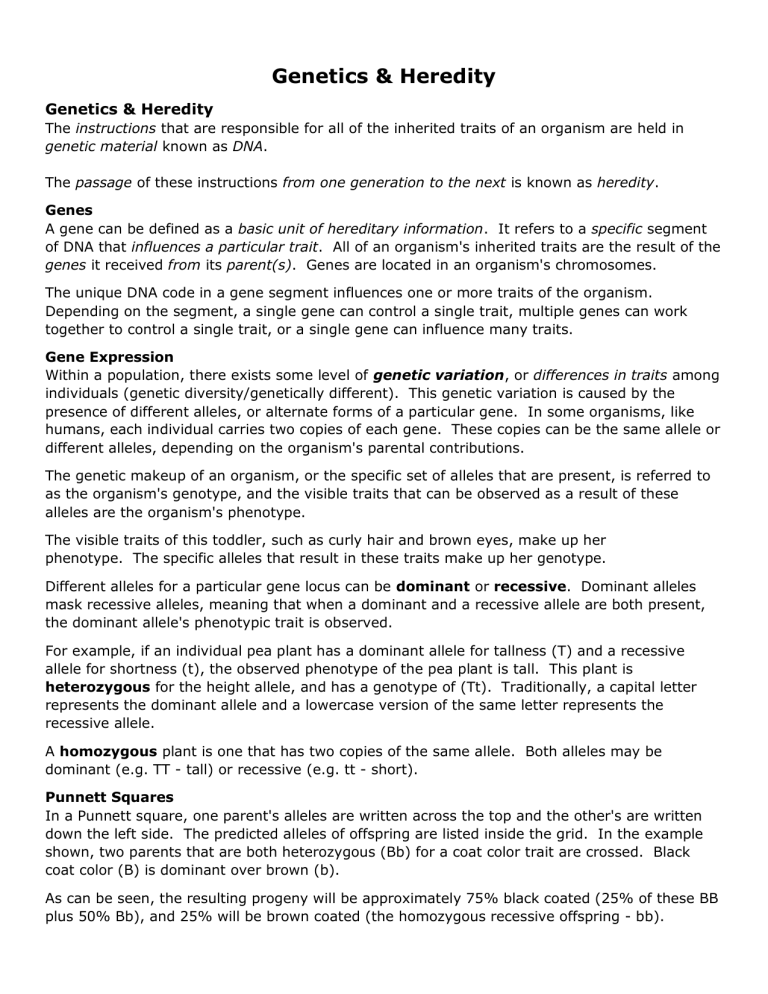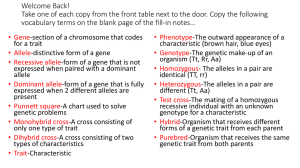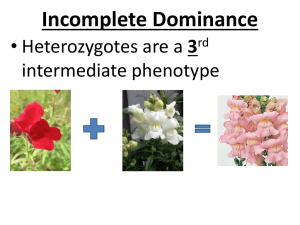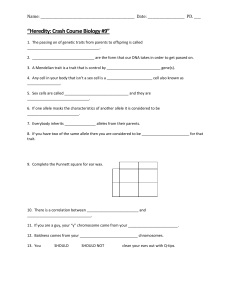
Genetics & Heredity Genetics & Heredity The instructions that are responsible for all of the inherited traits of an organism are held in genetic material known as DNA. The passage of these instructions from one generation to the next is known as heredity. Genes A gene can be defined as a basic unit of hereditary information. It refers to a specific segment of DNA that influences a particular trait. All of an organism's inherited traits are the result of the genes it received from its parent(s). Genes are located in an organism's chromosomes. The unique DNA code in a gene segment influences one or more traits of the organism. Depending on the segment, a single gene can control a single trait, multiple genes can work together to control a single trait, or a single gene can influence many traits. Gene Expression Within a population, there exists some level of genetic variation, or differences in traits among individuals (genetic diversity/genetically different). This genetic variation is caused by the presence of different alleles, or alternate forms of a particular gene. In some organisms, like humans, each individual carries two copies of each gene. These copies can be the same allele or different alleles, depending on the organism's parental contributions. The genetic makeup of an organism, or the specific set of alleles that are present, is referred to as the organism's genotype, and the visible traits that can be observed as a result of these alleles are the organism's phenotype. The visible traits of this toddler, such as curly hair and brown eyes, make up her phenotype. The specific alleles that result in these traits make up her genotype. Different alleles for a particular gene locus can be dominant or recessive. Dominant alleles mask recessive alleles, meaning that when a dominant and a recessive allele are both present, the dominant allele's phenotypic trait is observed. For example, if an individual pea plant has a dominant allele for tallness (T) and a recessive allele for shortness (t), the observed phenotype of the pea plant is tall. This plant is heterozygous for the height allele, and has a genotype of (Tt). Traditionally, a capital letter represents the dominant allele and a lowercase version of the same letter represents the recessive allele. A homozygous plant is one that has two copies of the same allele. Both alleles may be dominant (e.g. TT - tall) or recessive (e.g. tt - short). Punnett Squares In a Punnett square, one parent's alleles are written across the top and the other's are written down the left side. The predicted alleles of offspring are listed inside the grid. In the example shown, two parents that are both heterozygous (Bb) for a coat color trait are crossed. Black coat color (B) is dominant over brown (b). As can be seen, the resulting progeny will be approximately 75% black coated (25% of these BB plus 50% Bb), and 25% will be brown coated (the homozygous recessive offspring - bb). Pedigrees A pedigree chart shows how members of a certain family are related to each other, and it shows which members of the family express a certain trait or set of traits. In a pedigree chart, males are represented with squares, and females are represented with circles. mates are connected by a horizontal line between their symbols. offspring and siblings are represented by vertical lines that connect to the horizontal line between the parents. symbols that are shaded represent individuals that express a certain trait or set of traits. The above pedigree chart shows two generations. In the first generation, a female that expresses a certain trait mates with a male that does not express that trait. They have two children—50% express the trait—the female does not express the trait, but the male does express the trait. Both of the children mate with individuals that do not express the trait.






